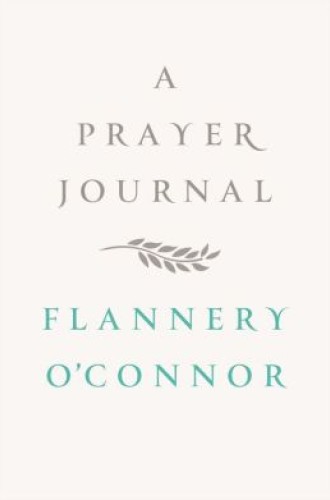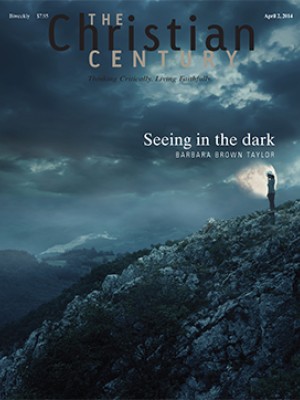A Prayer Journal, by Flannery O’Connor
When Flannery O’Connor was 20, she was a graduate student at the Iowa School for Writers, almost a thousand miles from her home in Milledgeville, Georgia, and was on her own for the first time in her life. From January 1946 to September of the following year she kept a journal of prayers and musings in what was once a student’s familiar mainstay: a black-and-white composition book. (A facsimile of her handwritten journal is appended to the edited text in this volume.)
In an early entry in this journal O’Connor attempted to define exactly what she was writing. It was not really a prayer journal, she said, because it was too “premeditated.” Nevertheless, she did include God in her thoughts, and she offered frequent fervent prayers. At one point she prayed, “Please let Christian principles permeate my writing and please let there be enough of my writing (published) for Christian principles to permeate.” It is clear from the beginning that this young woman was not writing just for herself, God, and an elite group of writing peers. Her stories were driven by her faith, and she was eager for publication and an audience with ears to hear her wild and violent stories about a world that requires “large and startling pictures” to shatter it into the recognition of God’s grace.
Read our latest issue or browse back issues.
The introduction to this slim volume, written by W. A. Sessions, one of O’Connor’s friends, reveals the penchant of some scholars, and all of O’Connor’s biographers, to minimize the faith aspects of her work as an idiosyncrasy that readers must tolerate in order to get through to the artistry and the humor. For Sessions the experience of faith seems oddly distant. He writes of O’Connor’s early life in Savannah as being permeated by “a series of Catholic rituals and teachings.” One cannot argue with this conclusion, mechanistic as it is, but it omits entirely any place for devotion and “mystery,” which O’Connor vociferously claimed is essential for any Catholic artist. Later Sessions uses dismissive quotation marks as he comments, “She would have to wait patiently in a world of triviality . . . until ‘the Lord’s’ response came.’” For O’Connor the Lord was not a vague concept to be treated ironically with scare quotes. The Lord and his mother were lifeblood itself.
The prayers in this journal are beautiful and heartfelt, written to a God O’Connor knew was present and listening. Her first entry, which begins in media res, earlier pages having been removed, contains this prayer:
Dear God, I cannot love Thee the way I want to. You are the slim crescent of a moon that I see and my self is the earth’s shadow that keeps me from seeing all the moon. The crescent is very beautiful and perhaps that is all one like I am should or could see; but what I am afraid of, dear God, is that my self shadow will grow so large that it blocks the whole moon, and that I will judge myself by the shadow that is nothing. I do not know You God because I am in the way. Please help me to push myself aside.
That O’Connor wanted to avoid the fatal narcissism of her age is notable, especially in one so young. She wanted, she said, to become “intelligently holy,” and although she felt that her work was worthy, she used the word mediocre over and over to describe the state of her soul.
She fought off pride even while she recognized its lure: “But I do not mean to be clever although I do mean to be clever on 2nd thought and like to be clever & want to be considered so.” Like the 17th-century poet George Herbert, who castigated himself for his “quaint words . . . curling with metaphors”—language that he felt fell far short of the plainly spoken “My God, My King”—O’Connor struggled with her motives and her vocation:
I want so to love God all the way. At the same time I want all the things that seem opposed to it—I want to be a fine writer. Any success will tend to swell my head—unconsciously even. If I ever do get to be a fine writer, it will not be because I am a fine writer but because God has given me credit for a few of the things He kindly wrote for me.
She added, “Right at present this does not seem to be His policy.” O’Connor prayed for her work and would continue to do so all of her life: in 1958 she traveled to Lourdes to take the healing baths, ostensibly for her health, which was deteriorating due to lupus, but she admitted later that while in the water she prayed not for her health but for her stories.
What exactly would provoke a young woman to begin to keep a journal to God? The journal itself reveals her motives. It seems that O’Connor had achieved intelligent holiness, but she constantly felt that an ingredient was missing. “I do not mean to deny the traditional prayers I have said all my life; but I have been saying them and not feeling them,” she wrote in her first entry. This journal was her attempt to stir up feeling and to keep it alive—that is, to feel close to God and to bask in the warmth. This plea comes up over and over again. “Perhaps the feeling I keep asking for, is something again selfish,” she wrote. “I don’t want to be doomed to mediocrity in my feeling for Christ. I want to feel,” she pleaded again. The journal ends abruptly with yet another complaint about her distance from God: “My thoughts are so far away from God. He might as well not have made me. And the feeling I egg up writing here lasts approximately a half hour and seems a sham. I don’t want any of this artificial superficial feeling stimulated by the choir.”
A lesser writer and thinker or a mediocre believer would probably have drifted off into despair at this realization. But O’Connor clearly lived a faith life and an artistic life that transcended these early cries of futility. At the age of 21, with only 18 more years of life ahead, she seems to have reached a conclusion that she explored later in her numerous letters to Betty Hester: “We [Catholics] don’t believe grace is something you have to feel.” She said later:
There is a question whether faith can or is supposed to be emotionally satisfying. I must say that the thought of everyone lolling about in an emotionally satisfying faith is repugnant to me. I believe that we are ultimately directed Godward but that this journey is often impeded by emotion.
Although O’Connor continued to write prose that was not fiction—letters, essays, book reviews—so far as we know she never again wrote a diary to God, and the prayers she offered later to friends in her correspondence were often established prayers of the church. She shed the sham, as she called it, and returned to established forms, quite unlike what she did in her fiction, which is surprising, humorous, peculiar, violent, utterly original, and unsentimental and which jars readers emotionally and spiritually. She wrote wake-up calls for all of us.






